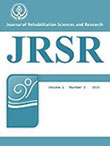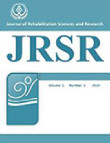فهرست مطالب

Journal of Rehabilitation Sciences and Research
Volume:4 Issue: 4, Dec 2017
- تاریخ انتشار: 1396/09/30
- تعداد عناوین: 5
-
-
Pages 89-96BackgroundAccording to the research literature, there was a relationship between cognitive functions of attention and working memory and linguistic skills. The aim of this research was to investigate the effect of cognitive rehabilitation on the improvement of the linguistic skills in 9-12 years old children with attention-deficit/hyperactivity disorder.Methods40 students in grade 4, 5 and 6 of a primary school in Miyane city were assigned equally and randomly to two intervention and control groups. The research design was experimental with pre-test, post-test, follow-up, and control group. The language tests included; Thurston Verbal Fluency task, Token test of receptive language, Boston naming speed test, Assessment of Persian Reading Ability (APRA), verbal working memory subtest of Wechsler Intelligence Scale for Children, and Attention Register task. Parental version of the Swanson, Nolan, and Pelham (SNAP-IV) questionnaire was used to screen ADHD. The intervention method was based on Attentive Rehabilitation of Attention and Memory (ARAM) with emphasis on attention and working memory. Mixed ANOVA statistical test was used to analyze the data.ResultsThe results showed that the linguistic skills assessed in the research which include naming (F=29.42, P=0.01), verbal fluency (phonological fluency: F=15.68, P=0.01; semantic fluency: F=13.73, P=0.01), reading abilities (alphabet reading 1: F=17.84, P=0.01; alphabet reading 2: F=27.07, P=0.01; word reading: F=19.82, P=0.01; reading ability: F=19.97, P=0.01; voice change: F=13.47, P=0.01; reading comprehension: F=36.85, P=0.01), comprehension (F=6.75, P=0.01), verbal working memory (direct digits: F=7.7, P=0.01; inverse digits: F=14.26, P=0.01) and attention (attention registration 1: F=10.23, P=0.01; attention registration 2: F=4.33, P=0.04) were improved, following the intervention.ConclusionComputerized Training of working memory and attention can enhance the language skills in children with ADHD. This result confirmed the role of attention and working memory on language skills.Keywords: Attention-Deficit-Hyperactivity Disorder, Cognitive Rehabilitation, Naming, Reading Abilities, Verbal Fluency
-
Pages 97-101BackgroundReading comprehension is one of the primary skills required of students in elementary schools. Various factors can influence this skill, including bilingualism. Owing to the variety of languages and dialects in Iran, a large number of students learn Farsi as a second language; consequently, they are faced with numerous challenges in acquiring high-level skills such as reading and writing. The present study was aimed at comparing reading comprehension and reading accuracy between bilingual Arabic and Farsi-speaking and monolingual Farsi-speaking fifth grade children in Ahvaz.MethodsThis cross-sectional, descriptive analytic study was carried out employing a random sample of 165 bilingual students (91 girls and 74 boys), and 159 monolingual students (79 girls and 80 boys). The students were evaluated in terms of reading accuracy and comprehension skills using some selected parts from a reading test developed by Shafei et al., in 2009. Finally, mean scores were compared between the two groups employing the independent samples t-test.ResultsBoth reading comprehension and accuracy were significantly higher in monolinguals compared to bilingual Arabic/Farsi-speaking students (P=0.000). Gender stratified results showed higher levels of reading comprehension skills in both monolingual girls (P=0.000) and boys (P=0.03) in comparison to bilinguals. However, in the reading accuracy subtest, only monolingual girls had a significantly superior performance than the bilinguals (P=0.000).ConclusionOverall, our results showed lower levels of reading comprehension and accuracy skills in bilingual fifth grade students in comparison to their monolingual peers in the city of Ahvaz. It seems that even in the late elementary school years, bilingual children have not attained the same level as their monolingual peers. Due to the importance of reading skills in academic achievement and day-to-day life, we highly recommend the implementation of measures toward improving these skills among bilingual elementary school students.Keywords: Arabic - Farsi-speaking_Bilingualism_Reading Accuracy_Reading Comprehension
-
Pages 102-108BackgroundSpecific language impairment (SLI) is one of the most common disorders of language development in children, which has been less addressed in Persian studies. The aim of this study was to evaluate the grammatical characteristics of Persian-speaking children with SLI using Photographic Expressive Persian Grammar Test (PEGT).MethodsThis case-control, cross-sectional study was conducted on 16 children with SLI and 16 normal children aged 4-6 years, who were monolingual Persian speakers. The subjects in both groups were age- and gender-matched. After selecting each participant, PEGT was administered and results were recorded in an answer sheet and analyzed. To analyze the data, the mean total scores of the test and mean scores related to each syntactic structure of the PEGT were compared between the two groups using MannWhitney test.ResultsIn this study, a significant difference was observed in mean total scores of the test between the studied groups. In detail, the mean score of the normal group was significantly higher as compared with the SLI group (PConclusionAccording to the results of the present study, children with SLI had weaker performance as compared with their normally developing age-matched peers in evaluated morphosyntactic structures.Keywords: Specific language impairment, Test, Persian, Children
-
Pages 109-113BackgroundThe purpose of this study was to compare the results obtained from phonemic fluency test using F1, A2, S3 and L4, T5,M6 among Persian Speakers aged between 20 and 30 years.MethodsIn this applied study, 76 subjects were randomly chosen. The data was analyzed separately for each subject according to the three letters: F, A, and S by using the routine phonemic fluency subtest of verbal fluency test and then phonemic fluency performance was gathered by using the three letters: L, T and M and after scoring according to Troyer method, the resultant numbers were reported after statistical analyses. For statistical analysis using SPSS 19, the distribution of data was firstly evaluated. Due to the fact that the data distribution was normal, Bonferroni test was used to compare the scores of the letters.ResultsNo significant gender and educational level effects were found and therefore, all further analyses were conducted without taking gender and educational level into account. Also, when the results of the three letters: F, A and S as a group for phonemic fluency performance and L, T and M letters as a different group, were integrated, a significant difference was found between the mean cluster size and switching between these two groups, while there was no significant difference between the average cluster size and cluster number.ConclusionBased on the findings of this research, it can be concluded that the results of phonemic fluency test in each of the six letters are significantly different. Therefore, when using the special letters in the Persian language, it is necessary to examine all the letters for phonological sub-tests and use the simplest letters to study this function.Keywords: Phonemic Fluency, Mean Cluster Size, Switching
-
Pages 114-119BackgroundValid assessment and validation indices are very important to evaluate and teach students, especially in clinical education settings. Considering the fact that rehabilitation science fields have about 1200 h of clinical education, planning of clinical skills training and how to evaluate them is important to improve the quality of education. Due to the importance of clinical skills teaching, clinical logbooks are used in various medical sciences in the world and some of the fields of medical sciences in Iran. This study was conducted to design and evaluate a clinical logbook for rehabilitation fields.MethodsStudents [153] and trainers [43] surveys were conducted on how to evaluate clinical units. The clinical training logbooks of reputable rehabilitation universities of the world were studied and clinical activity logbooks for different rehabilitation fields were designed and administered in the clinical education and governance council meetings. Then, the level of satisfaction of trainers and students with the evaluation method was investigated using the logbook.ResultsThe results of this research showed a significant increase in students satisfaction with the assessment of internship and improvement of the quality of clinical education (above 80%) (P=0.02). Content validity results for the questionnaire were above 68% and Cronbachs coefficient alpha was 75%.ConclusionGiven the similarity of internship courses throughout Iran, the logbook can be used in rehabilitation fields in the country by discipline to evaluate the clinical dimension of rehabilitation courses.Keywords: Rehabilitation, Logbook, Clinical Skills


